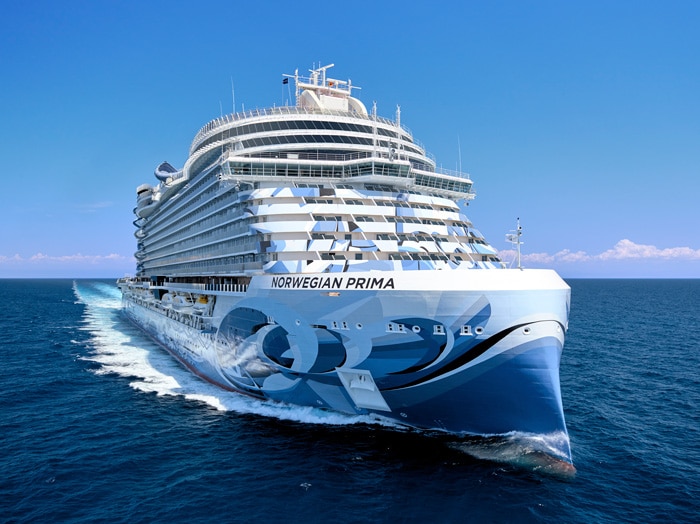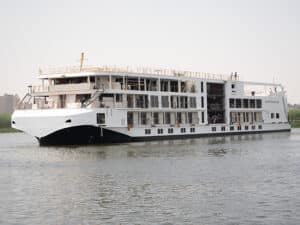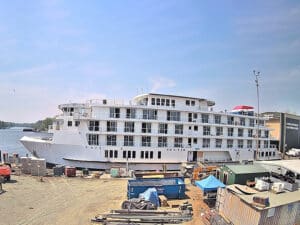
Cruising: Pleasing the guests is the easy part
Written by Nick Blenkey
Norwegian Prima, the first ship in Norwegian Cruise Lines’s Prima Class, is not LNG fueled, but Norwegian is taking a hard look at methanol. (Credit: Norwegian Cruise Line)
Back in revenue operations after an around 500 days pause imposed by COVID regulations, the good news for the cruise industry is that the market for its product didn’t go away. Bookings are at healthy levels, and so are all sorts of indicators of future demand.
The bad news, of course, is that the industry had to borrow massively to stay afloat through the shut down and has a huge debt burden.
That has investors and lenders jittery. One recent indication of this came last month when the world’s largest cruise company—Carnival Corporation & plc—gave a third quarter business update that had many positive trends to report.
Significantly, adjusted EBITDA for the third quarter of 2022 was over $300 million, turning positive for the first time since the resumption of guest cruise operations and marking a significant milestone. EBITDA, short for earnings before interest, taxes, depreciation and amortization, is one of the most widely used measures of a company’s financial health and ability to generate cash. It’s seen as giving a good picture of the core profit of a company and a quick snapshot of its available cash flow. And though Carnival’s EBITDA and its revenues were up, it still reported a net loss of $770 million. The numbers fell short of what Wall Street analysts expected and, almost as soon as they came out, the price of Carnival’s stock started to fall and was down by more than 20% at the end of the trading day, with the two other big cruise stocks, Royal Caribbean and Norwegian, taking collateral damage and also falling.
All of this means that the major cruise lines who order ships with billion dollar price tags are in no hurry to take on further debt by extending their newbuilding programs beyond their current pipeline.
That said; don’t expect them to stay away forever. Newbuilds are major draws in the cruise market—and historically the way they have been financed has worked well for the industry.
Norwegian Cruise Lines CFO Mark Kempa explained how it worked in a call with analysts in August:
“In general, approximately 20% of the ships cost is due in four installments tied to various milestones preconstruction beginning at contract signing. Typically, 80% of the cost is then due upon taking delivery of the ship. However, while this looks like a large capital expenditure outlay in the financial statements, we also received very efficient export credit agency-backed financing at the same time. This ECA-backed financing covers approximately 80% of the ship cost, which, as I mentioned earlier, is committed prior to contract signing and at extremely attractive rates. In certain cases, we also structure pre-delivery financing in order to better max the timing of cash flows. Amortization payments on this deck began six months after delivery of each vessel and continue over 12 years.
“An often overlooked but incredibly important facet in the cash flow mechanics of a new build timeline is that well prior to a delivery of a vessel, we are already receiving significant cash inflows in the form of advanced ticket sales and onboard presales. Given that final payments from our guests are typically due 120 days prior to a sailing, this is when the cash engine begins to come to life. As a rough estimate, we typically receive in the range of $100 million to $150 million of cash inflow from future bookings prior to a vessel’s first revenue sailing, resulting in a cash infusion into the business that continues to build over time as final payments for future voyages also become due.”
The Pipeline
Currently, there are around 70 oceangoing cruise ships worth a total up to $44 billion dollars on order at world shipyards for delivery between 2022 and 2027, with Fincantieri, Chantiers de l’Atlantique and the two Meyer Werft yards (Papenberg and Turku) accounting for most of them
Any new orders booked over the next several months are likely to come for ships in the 1,000 passenger and under category, and, in one of the first signs of a break in the ordering lull, in July, Explora Journeys, the luxury travel brand of the privately held, Swiss-based MSC Group’s cruise division (the world’s third largest cruise sector player), signed a memorandum of agreement with shipbuilder Fincantieri covering the construction of an additional two 922-passenger luxury cruise ships.
MSC opts for LNG
Something to note here is that MSC Group’s main activity is container shipping, a highly profitable sector recently, and that it has been leader in introducing LNG-fueled containerships. New generation LNG-fueled engines with reduced methane slip will power these two new cruise ships. They will also feature a containment system for liquid hydrogen that will power a 6 MW fuel cell, delivering emissions-free power for hotel operations and allowing for zero-emissions operations in port, with the engines turned off.
The two newbuilds—the Explora V and Explora VI—will come into service in 2027 and 2028, respectively, taking the Explora Journeys fleet to six ships. In a change of the original plan, Explora Journeys’ previously announced vessels Explora III and Explora IV will now also be powered by LNG. The two ships will be enlarged by 19 meters to enable the installation of a new generation system based on LNG and hydrogen. This has provided an opportunity to enhance the mix of suites with an increased number of spacious and luxurious Ocean Residences and larger public spaces.
The brand’s first ship, the 922-passenger Explora I, was floated out from Fincantieri’s Monfalcone, Italy, shipyard earlier this year and is on track to set sail in May 2023, while its second ship is set for delivery in 2024. The 14-deck vessels will each have four swimming pools, including one with a retractable roof and 461 suites.
The two additional ships covered under the MOA will bring MSC Group’s investment in the Explora fleet to EUR 3.5 billion (about $3.56 billion). This includes an additional EUR 120 million (about $122 million) each for fitting Explora III and Explora IV with LNG engines, a change that required a temporary halt of work due to the significant redesign of the ships. They will now be delivered in 2026 and 2027.
MSC Group main cruise brand, MSC Cruises, meantime, is set to take delivery in November of what will be the world’s largest LNG-fueled cruise ship, the MSC World Europa. Built by Chantiers de l’Atlantique it will have a length of 332.8 meters (1,092 feet) and the capacity for 6,774 passengers and 2,138 crewmembers.
The ship’s energy saving features will include new solid oxide fuel cell (SOFC) technology developed by MSC Cruises, Chantiers de l’Atlantique and Bloom Energy. The 150-kW SOFC demonstrator will generate auxiliary power and will be a testbed to accelerate the development of fuel cell technology, with MSC seeing it as offering the potential to enable hybrid propulsion solutions in the future.
Other significant LNG fueled vessels set to join the world fleet include Princess Cruises’ Sun Princess, the first of two new Sphere class vessels, currently under construction at Fincantieri’s Monfalcone, Italy, shipyard. The new 175,000-gt ship will be the brand’s largest ever and will accommodate over 4,000 guests. It will be the first Princess vessel to be LNG dual fueled and is one of 11 new ships in the overall Carnival Corporation fleet powered by LNG fuel technology.
Meantime Royal Caribbean’s first LNG dual-fueled ship, Icon of the Seas, is to deliver from Meyer Turku next year, with a capacity in the 5,000 passenger range, it, too, will include fuel cells in its power mix.
Methanol, Biofuels
Norwegian Cruise Lines recently joined the Methanol Institute, with Robin Lindsay, the company’s EVP of vessel operations, at saying that the company would “share key learnings from its feasibility assessment of retrofitting existing engines to operate with duel fuels—diesel and methanol.”
Since then, Norwegian—whose brands include Norwegian Cruise Lines, Oceania Cruises and Regent Seven Seas—has signed an MoU with MAN Energy Solutions that provides for retrofitting a medium-speed MAN 48/60 engine to make it capable of dual-fuel diesel/methanol operation.
Cruise lines are also looking hard at biofuels.
Richard Branson’s Virgin Voyages is looking to advance its commitment to reaching net zero by 2050 by what it calls “a portfolio approach to sustainable marine fuel supply.” It has partnered with the Roundtable on Sustainable Biomaterials and with three leading sustainable fuel providers, Argent Energy, GoodFuels and Twelve.



